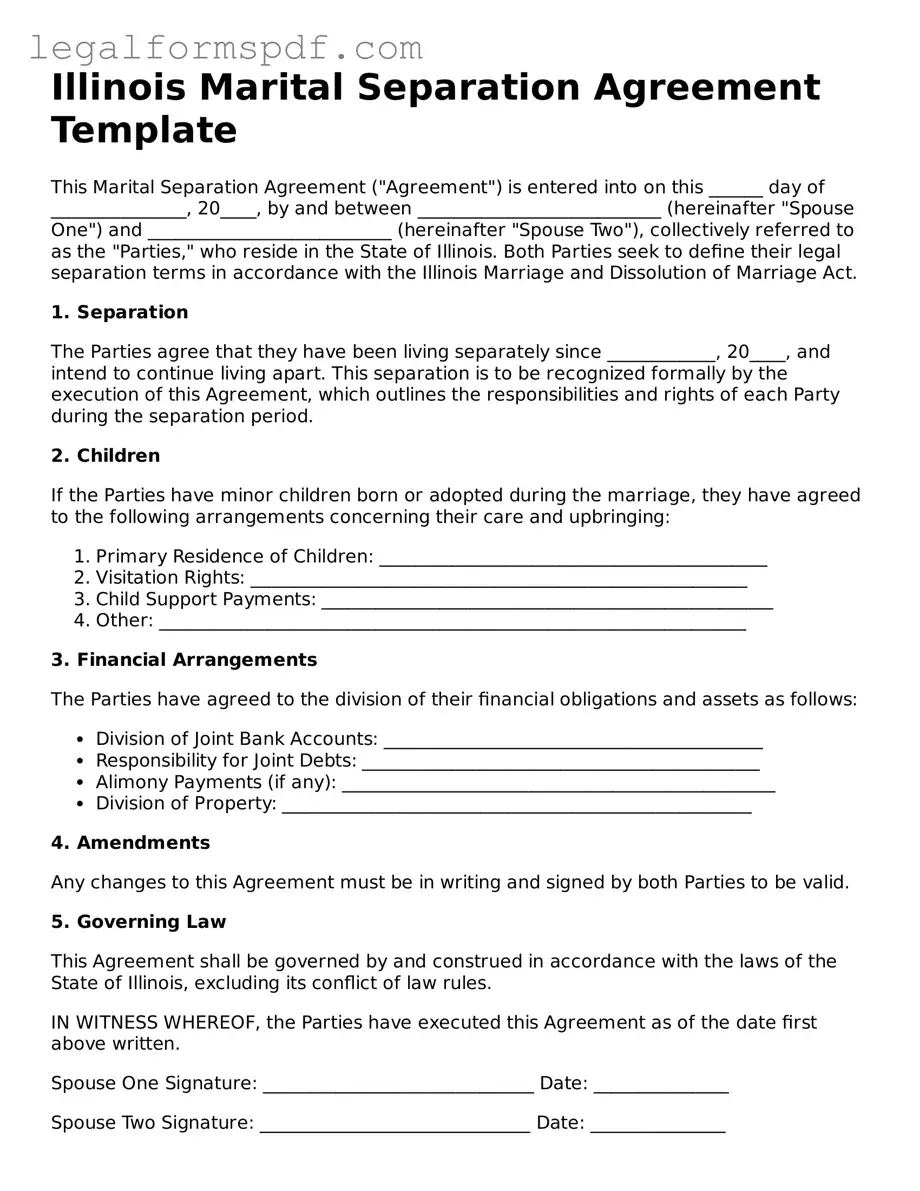A Marital Separation Agreement form, utilized by couples in Illinois who are contemplating separation but not immediate divorce, shares similarities with other legal documents that structure and formalize various aspects of personal and financial arrangements. Among these, a Prenuptial Agreement stands out, crafted before marriage to outline the division of assets and financial responsibilities in the event of divorce or separation. Both documents essentially plan for the financial future under changed relationships, yet their timing distinguishes them, with one setting the terms before marriage and the other after the marital relationship has commenced.
Close in relevance is the Postnuptial Agreement, formed after a couple is already married, designed to address the same concerns as a separation agreement regarding assets, debts, and other financial responsibilities during the marriage or in the event of a divorce. The key difference lies in the Postnuptial Agreement's application during the ongoing marriage, contrasting with the Marital Separation Agreement's intent towards separation or as a precursor to divorce.
The Divorce Decree, issued by a court to officially end a marriage, often encompasses agreements on assets, custody, and support similar to those found in a Marital Separation Agreement. The distinction here is the formal legal recognition of the end of the marriage through the decree, whereas the separation agreement works as a contract between the spouses defining terms during separation before finalizing a divorce.
A Child Custody Agreement, another related document, specifically addresses the terms concerning the care, custody, and support of children within the framework of separation or divorce. While it may form part of a broader Marital Separation Agreement, when drafted as a standalone document, it focuses exclusively on arrangements for the children, emphasizing their wellbeing and the parents' responsibilities.
A similar essential document is the Child Support Agreement, outlining the financial responsibilities of one parent to support the children financially after a separation or divorce. This agreement can be a component of the Marital Separation Agreement, specifically targeting the financial support necessary for the children's upbringing, distinct in its focus from the broader asset and property distribution questions.
Property Settlement Agreements resemble the asset division aspects of Marital Separation Agreements, specifically targeting how marital property is divided among spouses. These agreements can be standalone documents agreed upon during separation or divorce proceedings, focusing strictly on the distribution of jointly owned assets without addressing other aspects such as child support or custody.
Another related document is the Alimony Agreement, which specifically deals with the financial support one spouse agrees to provide the other post-separation or divorce. While alimony can be a part of a Marital Separation Agreement, as a standalone document, it zooms in on the conditions, amount, and duration of support, distinct from broader separation agreements that cover a multitude of terms.
The Debt Division Agreement is akin to the segments of a Marital Separation Agreement that deal with debts and liabilities. It specifies how both parties will manage and divide the debts accrued during the marriage, providing a focused approach on this aspect alone, unlike more comprehensive separation agreements which also encompass assets, children, and support.
Co-Parenting Agreements are specialized documents created by separating or divorcing parents to spell out each parent's responsibilities towards their children. Though it may share characteristics with a Marital Separation Agreement in terms of addressing child-rearing post-separation, its exclusivity to parenting arrangements without dipping into financial or property concerns sets it apart.
Finally, a Separation Maintenance Agreement, often seen in states that require a period of separation before divorce, outlines spousal and child support during this separation phase. It mirrors a Marital Separation Agreement in purpose and content but is applied within jurisdictions that necessitate such agreements as a prerequisite to legal divorce proceedings, focusing specifically on maintenance during the separation period.
